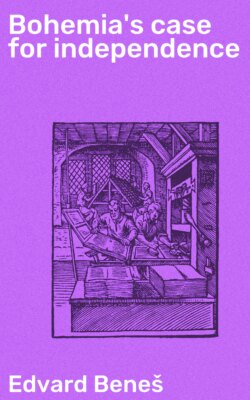Читать книгу Bohemia's case for independence - Edvard Beneš - Страница 4
На сайте Литреса книга снята с продажи.
Оглавление
The Czecho-Slovaks: Outline of their History
Table of Contents
BOHEMIA'S CASE FOR INDEPENDENCE
Table of Contents
I
THE CZECHO-SLOVAKS: OUTLINE OF THEIR HISTORY
The term Czecho-Slovaks, or simply the Czechs, includes two branches of the same nation: seven millions of Czechs living in Bohemia, Moravia, Silesia, and three millions of Slovaks inhabiting the north of Hungary, from the junction of the River Morava and the Danube to the Upper Tisza. These two peoples have the same civilisation, the same language and history: the Slovak dialect hardly differs from the Czech, certainly much less than the Slovene from the Serbo-Croat. The only obstacle to their complete union is one of a political character, the Czechs being under the yoke of Austria, while the Slovaks are under that of Hungary and the Magyars.
Till the middle of the nineteenth century, the ties which held them together were very close, and some of the most illustrious pioneers of the Czech renaissance were Slovaks. Towards the middle of the last century, certain Slovak patriots conceived the idea that in order to stir up the mass of the people to fight the Magyars, it would be advisable to abandon the Czech literary language, and adopt the local Slovak dialect. This separatist movement was accentuated by the establishment of the Austro-Hungarian dualism in 1867, which made the Slovaks members of another State, and completely separated them from the Czechs. This division of the two branches of the Czecho-Slovak nation has therefore existed only since the second half of the nineteenth century and has produced quite insignificant differences. By reason of their geographical position, the lot of the Slovaks has differed slightly from that of the Czechs; many of the sufferings which were inflicted on the Czechs were spared them, but on the other hand they sustained others which only indirectly affected the Czechs.
Briefly, the history of the Czecho-Slovaks may be summed up as follows:—
The Czech nation, inspired by a lofty idealism, has ever aimed throughout its history to attain to a high moral and religious conception of existence. Its activity has been concentrated on the search for moral and philosophical truths, and the realisation of ideals of justice and humanity. To this end the people of this nation have wished to live in the peace that allows of the fulfilment of such aims.
But the attainment of this peace has been opposed by three foes: firstly, up to the fifteenth century, by the Germans; secondly, by the Habsburg dynasty, who made use of the Germans in their endeavour to exterminate the Czechs; finally, by the Magyars, the traditional allies of the Germans, who tried to extirpate the Slovaks.
Inhabiting the most western of the Slav territorles, wedged deeply into the German block and surrounded by Magyars on the east, the position of the Czecho-Slovaks has made their history a history of perpetual struggle. There is not a single period in the history of this people which does not record a conflict with one or another of these three enemies. And the struggle continues.
It is a significant fact that today these three adversaries are considered the most malignant enemies of humanity: the history of the Czech nation shows that it was ever thus. If Europe to-day groans under the German-Austro-Magyar brutality, it must not be forgotten that the Czecho-Slovak nation has suffered under it for twelve hundred years. During these twelve centuries the Czechs were never the aggressors. With great difficulty they defended themselves, and only by a miracle escaped the fate of their unhappy brother Slavs of the Elbe.
It must be confessed that fate was not kind in placing us in such circumstances. Let us take our enemies one by one and review the events of the struggle.
